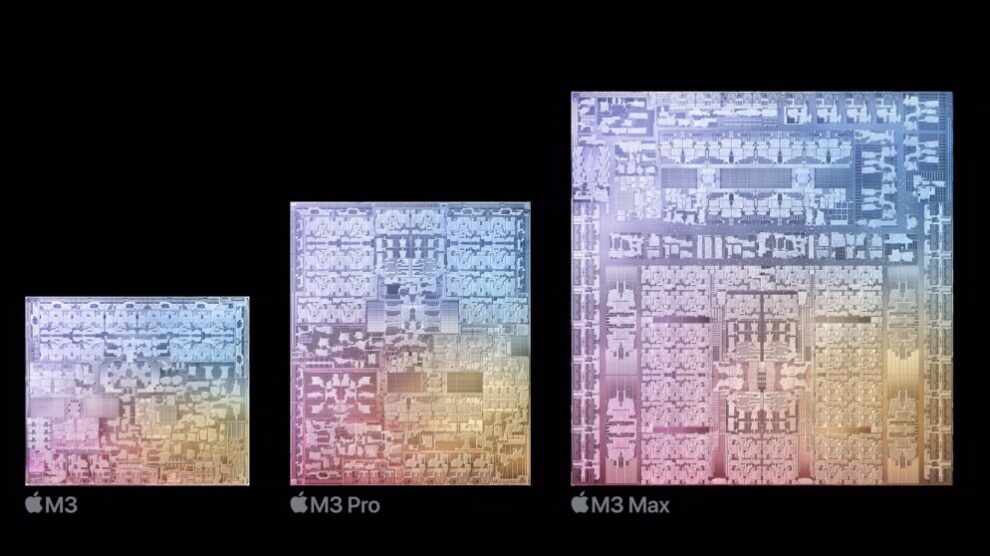Apple is going all in on its next generation M3 silicon, investing an estimated $1 billion on the M3 chip tape-out according to semiconductor analyst Jay Goldberg from Digits to Dollars. This astronomical sum provides deep insight into just how complex and powerful Apple’s new M3 chipset will be.
The M3 is poised to power Apple’s 2023 MacBook Air, MacBook Pro, Mac mini, and iMac models. Let’s take a closer look at what the monumental M3 tape-out investment means for Apple and consumers.
What is Chip Tape-Out?
First, what exactly does “tape-out” mean? Tape-out is the final stage of the chip design process before sending the blueprint to fabrication. It involves creating photomasks of the chip layout which serve as a stencil for the fabrication process.
Tape-out is extremely complex and expensive for sophisticated chips like the M3. During tape-out, the chip design undergoes physical verification, analysis of parasitic effects, mask data preparation, and final photomask creation.
The photomasks imprint the computer chip pattern onto silicon wafers. Each mask layer correlates with a fabrication step required to build up the 3D integrated circuit.
Tape-out is a milestone that signals the chip design is ready to be manufactured. Apple’s $1 billion expense on M3 tape-out gives us huge insight into just how complex a beast the M3 will be.
The M3 Chip Is Apple’s Most Advanced Yet
The M3 chip represents the next generation in Apple silicon. It will succeed the current M2 chip found in the latest 2022 MacBooks.
Reports indicate the M3 will be fabricated on TSMC’s cutting-edge 3nm node manufacturing technology. This represents an even denser transistor packing compared to the 5nm process used for the M2 chip.
Apple chip architect Jeff Wilcox says the M3 will feature a completely redesigned compute core and a new neural engine. Improvements to quality, performance, and power efficiency are all expected.
Notably, the M3 is rumored to pack a whopping 12 CPU cores consisting of 8 high-performance cores and 4 efficiency cores. This core count is double the M2 chip.
The 12-core CPU lineup also matches the highest core count found in Apple’s professional M1 Max chip. Yet the M3 is meant for consumer devices like the MacBook, not pro workstations.
This reveals Apple’s intent to bring immense processing power to mainstream consumers. Combine the amped up core count with the efficiency of 3nm transistors, and the M3 will be Apple’s most advanced chip ever.
Why Tape-Out Cost Apple $1 Billion+
But why does taking the M3 chip to tape-out cost Apple over $1 billion? Simply put, developing leading-edge silicon at scale is incredibly difficult and expensive.
First, the M3 chip is projected to pack a massive 140 billion transistors. That makes it one of the most complex and dense chips on the planet. For comparison, Intel’s flagship Core i9-13980HX tops out at just 24 billion transistors.
Creating the intricate photomasks for a 140 billion transistor chip is an immensely intricate process prone to high costs and low yield. The fabrication of mask sets alone likely accounts for hundreds of millions in tape-out costs.
Next, Apple has to produce test chips, verify the design, and validate M3 performance before launch. This requires an army of chip architects, engineers, software developers, and testing equipment adding more millions.
Advanced EDA software tools used to design, simulate, and validate the M3 also cost a fortune. Apple’s tape-out expense goes towards licensing this cutting-edge EDA software from firms like Synopsys and Cadence.
And of course, Apple plans to mass produce tens of millions of M3 chips annually. The M3 masks must be highly durable and repeatable. This level of scale and reproducibility drives up mask and test wafer expenses.
Considering these points, it’s no surprise that the M3 tape-out has ballooned into the billion dollar range. The M3 is shaping up to be Apple’s biggest chip investment ever.
How M3 Performance Could Justify the Investment
Developing headline silicon like the M3 isn’t cheap. But the performance and efficiency gains stand to outweigh the costs in the long run.
Based on early speculation and rumors, here are some of the ways the M3 chip may ultimately justify its massive development expense:
- Blazing fast CPU performance – The 12-core design combined with 3nm fabrication could enable the M3 chip to surpass 16-core desktop CPUs in multi-threaded task processing while using a fraction of the power.
- Next-level GPU – Expect Apple’s custom graphics to erase any remaining leads by Intel and AMD mobile GPUs. The M3 graphics should excel in gaming, video editing, 3D workloads.
- Supercharged AI – An all-new neural engine paired with the 3nm transistor tech will deliver enormous machine learning gains. Complex AI workflows on device will be fast and seamless.
- Radical power efficiency – The M3 will surely raise the bar for performance per watt across both CPU and GPU. Apple’s chips already dominate in power efficiency.
- Longer battery life – Thanks to power efficiency savings, an M3 MacBook Air could potentially deliver over 20 hours of battery life with mixed usage.
- Faster memory – Expect memory bandwidth to double from 100GB/s in the M2 to 200GB/s or higher in the M3 allowing the CPU and GPU to operate at peak speed.
Just looking at these speculative improvements reveals how Apple could recoup its massive M3 investment and then some. The next-gen chip will keep Apple devices untouchable in silicon performance for years to come.
What Will the M3 Chip Power?
It’s expected the M3 chip will make its debut in the 2023 refresh of the MacBook Air. Apple typically brings new silicon to the consumer MacBook first.
The M3 chip is likely to eventually power the full range of Mac devices. Here’s a look at some of the anticipated Apple products that will utilize the M3 silicon:
2023 MacBook Air – The next-gen M3 MacBook Air promises massive gains in battery life, power, and performance. It could easily be 2-3x faster than the M1 model while lasting over 20 hours on battery.
2023 MacBook Pro 13″ – Look for the M3 to bring similar jumps in speed and efficiency to Apple’s entry-level pro laptop. The four Thunderbolt ports will provide plenty of bandwidth to take advantage of M3 power.
2023 Mac mini – The Mac mini will give customers an affordable entry point into the M3 ecosystem. Expect CPU gains on par with high-end gaming PCs but with a tiny footprint using just a fraction of the power.
2023 24-inch iMac – The colorful iMac embodies efficiency and simplicity. With the M3 chip, expect all-day battery life when paired with the wireless keyboard and trackpad. The M3 will turn the iMac into a productivity and creative powerhouse.
2023 iPad Pro – The M3 chip in the iPad Pro could enable desktop-class workflows and AAA gaming capabilities while untethered. Apple’s tablet is already leading the way in blurring the lines between mobile and PC.
As you can see, the M3 chip will make its way through the entire Mac and iPad lineup over the next two years. Apple’s silicon strategy is paying off tremendously allowing it to optimize performance and battery life across devices.
When Will Apple Announce the M3 Chip?
Apple has not officially confirmed the M3 chip yet, but there are some educated guesses we can make about the announcement and release timeframe.
First, rumors point to a March 2023 event where Apple could announce the first M3 powered MacBook Air. The actual on-sale date may fall in April or May.
This release cadence lines up with previous Apple chip launches:
- M1 unveiled November 2020, released November 2020
- M1 Pro/Max unveiled October 2021, released October 2021
- M2 unveiled June 2022, released July 2022
The M2 had a longer lead time from unveil to launch, so Apple may follow a similar schedule with announcing the M3 around March and release in late spring 2023.
Also expect Apple to hold one of its trademark keynotes to introduce the M3 to the world. This gives Apple executives a venue to highlight all the remarkable innovations and performance achievements of the new silicon.
We may see Apple CEO Tim Cook officially unveil the chip itself on stage along with its core specs and benchmarks. Meanwhile, other executives will demo the new M3 MacBook Air and hype up all the new features enabled by this powerful chip.
It’s going to be an exciting keynote for Apple fans as the M3 represents a giant leap forward. The massive $1 billion tape-out investment sets the stage for the M3 to shine as Apple’s best silicon yet.
Cost Analysis: M3 Chip vs Intel/AMD/Qualcomm
To put Apple’s $1 billion M3 tape-out budget into perspective, let’s compare it against the chip development spending from leading Intel, AMD, and Qualcomm.
Intel – Intel’s total annual research and development budget is around $13 billion. Out of this, the company invests approximately $3 billion into central processing unit design according to chief architect Raja Koduri.
For comparison, this means Apple spent 33% of Intel’s yearly CPU R&D budget on just the M3 tape-out alone. This demonstrates the massive resources and focus Apple is putting specifically into its custom silicon chips.
AMD – AMD invests around $2 billion per year into all research and development. The company has a wider range of products compared to Apple including CPUs, GPUs, APUs and more.
Apple’s $1 billion for the M3 tape-out equals about half of AMD’s entire yearly R&D spending. Again, this highlights Apple’s aggressive silicon investments.
Qualcomm – As the leader in mobile processors, Qualcomm budgets around $5 billion a year in R&D. Qualcomm designs mobile chipsets including application processors, modems, AI accelerators, GPUs and more.
Apple’s M3 tape-out cost is around 20% of Qualcomm’s total R&D annual budget. However, Qualcomm’s spending is spread across a wide range of products and technologies including 5G networking.
Looking at these numbers gives perspective on how Apple is devoting billions specifically into designing leading-edge Apple silicon like the M3. The huge investment in the M3 tape-out proves no other technology company can match Apple’s silicon focus and resources.
Apple Recouping M3 Costs Through Higher Mac Prices
Interestingly, Apple seems to already be pricing new Macs higher in anticipation of launching more expensive M3 models in 2023.
Across 2022, Apple increased prices on high-demand MacBook Pro models by 17-20%. The new 14-inch and 16-inch MacBook Pro now start at $1999 and $2499 respectively, up from $1799 and $2,499.
Mac mini pricing also jumped 17% to $599 for the M1 model. Meanwhile, the Mac Studio starts at $1999 compared to $1299 for the previous Intel Mac mini.
And reports suggest the 2023 MacBook Air will see a price hike to $1199 up from $999. Apple seems to be cushioning sticker shock by gradually raising Mac pricing over the past year.
This sets the stage for Apple to potentially maintain current profit margins on future M3 Macs despite the huge per unit chip costs.
By the time 2023 MacBook Airs with M3 hit the market for $1199, buyers will be acclimated to the new higher pricing versus feeling like they are paying a premium over the $999 M1 model.
It’s a strategic move by Apple to increase prices moderately over time rather than drastically raise rates all at once with the M3 launch. This pricing strategy helps recoup the enormous M3 development costs so Apple enjoys strong profitability.
The M3 Cements Apple as King of Chip Design
The jaw-dropping $1 billion spent on M3 tape-out exemplifies Apple’s silicon obsession. This enormous investment demonstrates unmatched commitment to designing the world’s best processors.
Since launching its first A4 chip in 2010, Apple has been on an unrelenting pace of chip innovation. Each new generation blows away the industry and sets the bar even higher.
Apple now designs best-in-class processors, graphics, neural engines, image processors, and other custom silicon. The M3 chip brings all this expertise together into one incredibly sophisticated system-on-a-chip.
And Apple is just getting started. The company is reportedly designing custom ARM-based server processors to eventually reduce reliance on Intel in the Mac Pro and iMac Pro.
Rumors also point to Apple planning its own cellular modem chip which could replace Qualcomm’s technology in future iPhones. Additionally, Apple has assembled a team to develop self-driving car processors.
The M3 chip for consumer Macs and iPads is just one piece of Apple’s unprecedented silicon strategy. Apple is leveraging its chip expertise across every product category from phones to computers to autonomous vehicles.
Thanks to Apple’s laser focus on custom silicon over the past decade, competitors like Intel and Qualcomm are now perpetually playing catchup. The soaring cost of the M3 tape-out only extends Apple’s multi-year chip dominance into the foreseeable future.
Impact of Apple’s Chip Investment on Consumers
Of course, Apple didn’t spend $1 billion on M3 tape-out solely for bragging rights. This enormous investment will pay off handsomely for Apple in the form of Mac sales, revenue, and profitability.
But the M3 chip also promises to have wide-reaching beneficial impact on consumers. Here are some of the key ways the M3 chip could improve the user experience:
- Blazing performance – The M3 will bring desktop-class speed to thin and light consumer MacBooks and iPads. Everyday tasks will feel fluid and snappy.
- Greater efficiency – Thanks to Apple’s chip expertise, consumers will get amazing battery life reaching up to 20+ hours on some M3 Macs.
- Cooler and quieter operation – The efficiency of the M3 chip means less heat production and loud fan noise when performing intensive work.
- More advanced features – Apple silicon enables new capabilities like ProRes video editing and advanced machine learning features using the neural engine.
- Reduced reliance on the cloud – Sensitive tasks can be processed on device rather than sending data to the cloud. M3 performance helps keep data secure and accessible offline.
- Lower cost of ownership – M3 models may cost slightly more upfront but the long usable lifespan ultimately leads to a lower total cost experience.
While the M3 tape-out carries a lofty $1 billion price tag, Apple’s investment results in better performing, more efficient computers and tablets. Consumers ultimately reap the rewards of Apple’s unrelenting silicon focus.
Outlook on Future M-Series Chips
Looking ahead, the M3 is only the first of a cadence of planned M-series chips from Apple using TSMC’s 3nm process. Similar to how the M1 begat the M1 Pro, Max, and Ultra, we can expect variations of the M3 to power devices ranging from the MacBook Air to the Mac Pro.
Beyond 2023 and the M3 generation, rumors point to TSMC 4nm and 3nm node evolutions which promise even greater power and performance efficiency.
This gives Apple a multi-year roadmap to deliver continuous leaps in its silicon capabilities. While tape-out for bleeding-edge chips like the M3 is frightfully expensive, it secures Apple’s computing future for years to come.
And the M3 tape-out cost is a drop in the bucket for Apple which raked in a staggering $394 billion in revenue in 2022. With hundreds of billions in sales and over $160 billion in cash reserves, Apple has essentially unlimited resources to fund its ambitious silicon roadmap.
In the long run, the billion dollar M3 tape-out investment will be a footnote as M3 powered devices dominate sales and generate hundred of billions in revenue.
Final Thoughts on the $1 Billion M3 Tape-Out
The eye-popping $1 billion spent on the M3 chip tape-out provides deep insight into Apple’s unrelenting focus on designing the world’s best silicon. After more than a decade of relentless chip innovation, the M3 represents Apple’s biggest chip investment yet.
The massive complexity of the M3 featuring up to 140 billion transistors makes this an unprecedented tape-out pushing Apple’s engineering talent to the limits. But the performance benefits stand to be equally unprecedented.
Consumers can expect up to 20 hours of battery life on some M3 models along with desktop-class CPU and graphics performance tailored for thin and light devices. The possibilities span from AAA gaming on an iPad to powering an AI-infused autonomous vehicle.
While the short term costs are high, Apple’s long term semiconductor strategy continues to pay off in an enormously impactful way. The M3 chip reaffirms Apple’s dominance in chip design and security.
Rival chipmakers like Intel, AMD, and Qualcomm face tough choices on whether to attempt matching Apple’s soaring investments. For now, Apple’s silicon expertise remains years ahead thanks to tape-out milestones like the extraordinary M3.
Frequently Asked Questions About the M3 Chip Tape-Out
Here are answers to some common questions regarding Apple’s $1 billion investment into the M3 chip tape-out:
What is tape-out in chip design?
Tape-out is the final stage before manufacturing where the chip’s photomasks are created as a blueprint for fabrication. The masks imprint the integrated circuit onto silicon wafers.
When will Apple release the first M3 chip?
Rumors point to a March 2023 announcement with devices like the MacBook Air with M3 chip coming in mid-2023. The keynote and product launch may fall around WWDC in June.
What improvements will the M3 chip bring?
Expect significant gains to CPU performance, GPU graphics, power efficiency, machine learning, memory bandwidth and more compared to the already fast M2










Add Comment